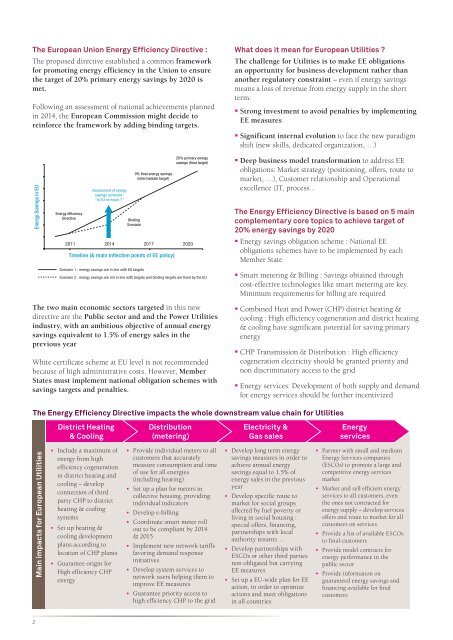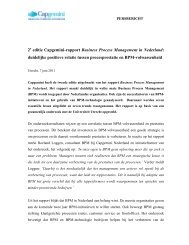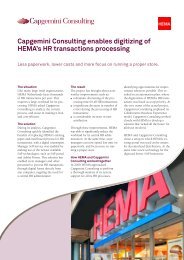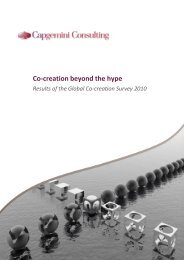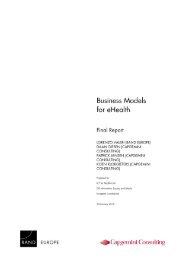PDF - 2.74 MB - Capgemini Consulting
PDF - 2.74 MB - Capgemini Consulting
PDF - 2.74 MB - Capgemini Consulting
Create successful ePaper yourself
Turn your PDF publications into a flip-book with our unique Google optimized e-Paper software.
The European Union Energy Efficiency Directive :<br />
The proposed directive established a common framework<br />
for promoting energy efficiency in the Union to ensure<br />
the target of 20% primary energy savings by 2020 is<br />
met.<br />
Following an assessment of national achievements planned<br />
in 2014, the European Commission might decide to<br />
reinforce the framework by adding binding targets.<br />
What does it mean for European Utilities <br />
The challenge for Utilities is to make EE obligations<br />
an opportunity for business development rather than<br />
another regulatory constraint – even if energy savings<br />
means a loss of revenue from energy supply in the short<br />
term:<br />
• Strong investment to avoid penalties by implementing<br />
EE measures<br />
• Significant internal evolution to face the new paradigm<br />
shift (new skills, dedicated organization, …)<br />
Energy Savings in EU<br />
Energy efficiency<br />
Directive<br />
Assessment of energy<br />
savings achieved :<br />
“is EU on-track ”<br />
Binding<br />
Scenario<br />
9% final energy savings<br />
(intermediate target)<br />
Timeline (& main inflection points of EE policy)<br />
20% primary energy<br />
savings (final target)<br />
2011 2014 2017 2020<br />
• Deep business model transformation to address EE<br />
obligations: Market strategy (positioning, offers, route to<br />
market, …), Customer relationship and Operational<br />
excellence (IT, process...<br />
The Energy Efficiency Directive is based on 5 main<br />
complementary core topics to achieve target of<br />
20% energy savings by 2020<br />
• Energy savings obligation scheme : National EE<br />
obligations schemes have to be implemented by each<br />
Member State<br />
Scenario 1 : energy savings are in line with EU targets<br />
Scenario 2 : energy savings are not in line with targets and binding targets are fixed by the EU<br />
• Smart metering & Billing : Savings obtained through<br />
cost-effective technologies like smart metering are key.<br />
Minimum requirements for billing are required<br />
The two main economic sectors targeted in this new<br />
directive are the Public sector and and the Power Utilities<br />
industry, with an ambitious objective of annual energy<br />
savings equivalent to 1.5% of energy sales in the<br />
previous year<br />
White certificate scheme at EU level is not recommended<br />
because of high administrative costs. However, Member<br />
States must implement national obligation schemes with<br />
savings targets and penalties.<br />
• Combined Heat and Power (CHP) district heating &<br />
cooling : High efficiency cogeneration and district heating<br />
& cooling have significant potential for saving primary<br />
energy<br />
• CHP Transmission & Distribution : High efficiency<br />
cogeneration electricity should be granted priority and<br />
non discriminatory access to the grid<br />
• Energy services: Development of both supply and demand<br />
for energy services should be further incentivized<br />
The Energy Efficiency Directive impacts the whole downstream value chain for Utilities<br />
District Heating<br />
& Cooling<br />
Distribution<br />
(metering)<br />
Electricity &<br />
Gas sales<br />
Energy<br />
services<br />
Main impacts for European Utilities<br />
• Include a maximum of<br />
energy from high<br />
efficiency cogeneration<br />
in district heating and<br />
cooling – develop<br />
connection of third<br />
party CHP to district<br />
heating & cooling<br />
systems<br />
• Set up heating &<br />
cooling development<br />
plans according to<br />
location of CHP plants<br />
• Guarantee origin for<br />
High efficiency CHP<br />
energy<br />
• Provide individual meters to all<br />
customers that accurately<br />
measure consumption and time<br />
of use for all energies<br />
(including heating)<br />
• Set up a plan for meters in<br />
collective housing, providing<br />
individual indicators<br />
• Develop e-billing<br />
• Coordinate smart meter roll<br />
out to be compliant by 2014<br />
& 2015<br />
• Implement new network tariffs<br />
favoring demand response<br />
initiatives<br />
• Develop system services to<br />
network users helping them to<br />
improve EE measures<br />
• Guarantee priority access to<br />
high efficiency CHP to the grid<br />
• Develop long term energy<br />
savings measures in order to<br />
achieve annual energy<br />
savings equal to 1.5% of<br />
energy sales in the previous<br />
year<br />
• Develop specific route to<br />
market for social groups<br />
affected by fuel poverty or<br />
living in social housing :<br />
special offers, financing,<br />
partnerships with local<br />
authority tenants…<br />
• Develop partnerships with<br />
ESCOs or other third parties<br />
non obligated but carrying<br />
EE measures<br />
• Set up a EU-wide plan for EE<br />
action, in order to optimize<br />
actions and meet obligations<br />
in all countries<br />
• Partner with small and medium<br />
Energy Services companies<br />
(ESCOs) to promote a large and<br />
competitive energy services<br />
market<br />
• Market and sell efficient energy<br />
services to all customers, even<br />
the ones not contracted for<br />
energy supply – develop services<br />
offers and route to market for all<br />
customers on services<br />
• Provide a list of available ESCOs<br />
to final customers<br />
• Provide model contracts for<br />
energy performance in the<br />
public sector<br />
• Provide information on<br />
guaranteed energy savings and<br />
financing available for final<br />
customers<br />
2


